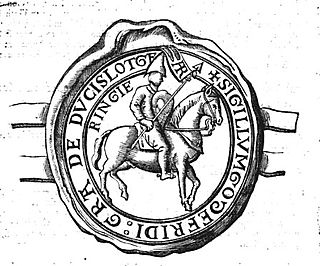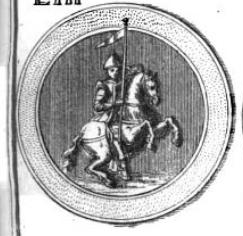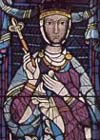
The coat of arms of Luxembourg has its origins in the Middle Ages and was derived from the arms of the Duchy of Limburg, in modern-day Belgium and the Netherlands. In heraldic language, the arms are described as: Barry of ten Argent and Azure, a Lion rampant queue forchée Gules crowned, armed and langued Or.

Godfrey I, called the Bearded, the Courageous, or the Great, was the Landgrave of Brabant, Count of Brussels and Leuven (Louvain) from 1095 to his death and Duke of Lower Lorraine from 1106 to 1129. He was also Margrave of Antwerp from 1106 to his death.

The House of Luxembourg or Luxembourg dynasty was a royal family of the Holy Roman Empire in the Late Middle Ages, whose members between 1308 and 1437 ruled as kings of Germany and Holy Roman emperors as well as kings of Bohemia, Hungary and Croatia. Their rule was twice interrupted by the rival House of Wittelsbach.
Sigfried was Count in the Ardennes, and is known in European historiography as founder and first ruler of the Castle of Luxembourg in 963 AD, and ancestor and predecessor of the future counts and dukes of Luxembourg. He was also an advocate of the abbeys of St. Maximin in Trier and Saint Willibrord in Echternach.

Henry the Blind, sometimes called Henry IV of Luxembourg, was his father's heir as count of Namur from 1136 until his death, and heir of his mother's family as count of Luxembourg from 1139 until his abdication in 1189. He also inherited the smaller lordships of Longwy, La Roche-en-Ardenne and Durbuy.

The County of Luxemburg was a State of the Holy Roman Empire. It arose from medieval Lucilinburhuc Castle in the present-day City of Luxembourg, purchased by Siegfried, Count of the Ardennes in 963. His descendants of the Ardennes–Luxembourg dynasty began to call themselves Counts of Luxembourg from the 11th century onwards. The House of Luxembourg, a cadet branch of the Dukes of Limburg, became one of the most important political forces of the 14th century, contending with the House of Habsburg for supremacy in Central Europe.
Gérard I of Durbuy, was the Count of Durbuy from 1247 to his death. He was the second son of Waleran III of Limburg and Ermesinda of Luxembourg.

Ermesinde ruled as the countess of Luxembourg from 1197 until her death. She was the only child of Count Henry IV and his second wife Agnes of Guelders.
Theobald I was Count of Bar from 1190 until his death, and a Count of Luxemburg from 1197 until his death. He was the son of Reginald II of Bar and his wife Agnès de Champagne. He became count when his brother, Henry, was killed in the siege of Acre.
Cunigunda of Sulichgau (893-924) was the daughter of Ermentrude of France, daughter in turn of Louis the Stammerer. Her father was Eberhard of Sulichgau, son of Unruoch III. In 898 her uncle Charles III gained control as king of the Franks, changing Cunigunda's life for the better.
The counts of Chiny were part of the nobility of Lotharingia that ruled from the 9th to the 14th century in what is now part of Belgium.
Arnold I, Count of Chiny, son of Louis II, Count of Chiny, and his wife Sophie. He succeeded his father as count before 1066.
Albert (Albert I) (before 1131 – 29 September 1162), Count of Chiny, son of Otto II, Count of Chiny, and Adélaïs of Namur. He succeeded his father before 1131 and spent most of his time in Chiny, not taking part in the various conflicts which shook the region.
Count Giselbert (or Gilbert) (d. before 1138), was the deputy advocate (subadvocatus) of Saint Trudo’s Abbey. At least by 1111 he began to be referred to as not just a count, but specifically the Count of Duras, and he may have been the first to be known under that title. He was son of Otto I, Count of Duras, and his wife Oda. Giselbert was involved in several conflicts which involved the abbey, as mentioned in several parts in the Abbey's Gesta or chronicle.
The Counts of Durbuy were Frankish noblemen in the 11th and 12th century who were descended from Albert II, Count of Namur. Durbuy is a municipality located in the Belgian province of Luxembourg apparently founded in the 11th century as no earlier mention of it has been found. A chronology of Durbuy can be found in the French Wikipedia article Chronologie de la Terre de Durbuy. The counts were descended from the families ruling Namur and then Limburg.
Henry I, Count of Durbuy, son of Albert II, Count of Namur, and Regilende, daughter of Gothelo I, Count of Verdun and Duke of Lorraine.
Conon was a Lotharingian nobleman and military leader of the First Crusade. He was one of the most prominent lords of the Ardennes, being the count of Montaigu, lord of Rochefort and advocate (defender) of the city of Dinant from 1064. He was also one of the most important vassals of the bishop of Liège, holding the county of Huy from the church. His chief seat was the castle of Montaigu, while the castle at Huy was the redoubt of the bishops.

In the 10th through 13th centuries, the Lords of Esch were the holders of the castle of Esch-sur-Sûre in the Ardennes region of Lower Lorraine, then a part of the Holy Roman Empire.

The house of Namur is a family of the Lotharingian nobility, coming from Berenger count of Lommegau. He later became count of Namur, when the county of Lammegau was renamed to county of Namur. He married a sister of Giselbert duke of Lotharingia, from the House of Reginar.
The House of Luxembourg (or Luxembourg), also known as the House of Ardenne–Luxembourg in order to distinguish it from later families, were a Lotharingian noble family known from the tenth and eleventh centuries. They are one of the three main branches of the House of Ardenne, along with the House of Ardenne–Verdun, and the House of Ardenne–Bar.